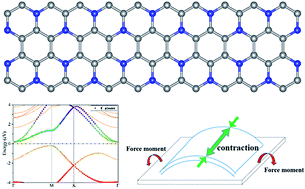First-principles study of two dimensional C3N and its derivatives†
Abstract
Here we have performed a comprehensive first-principles study for electronic and mechanical properties of newly synthesized C3N and its derivatives. The C3N monolayer is evaluated to be an indirect semiconductor with a HSE06 level bandgap of 1.09 eV, which can be effectively tuned by the number of layers, stacking order and B-doping concentration. With strong polar covalent bonds, C3N is predicted to be a superior stiff material with high in-plane Young's modulus (1090.0 GPa) and thermal dynamic stability (up to 2000 K). Remarkably, the C3N monolayer possesses a fascinating bending Poisson's effect, namely, bending induced lateral contraction, which is rare in other 2D materials. What's more, C3N nanosheets can be rolled into nanotubes with a tunable bandgap corresponding to the radius of curvature. Due to high stability, suitable band gap and superior mechanical strength, two dimensional C3N will be an ideal candidate in high-strength nano-electronic device applications.



 Please wait while we load your content...
Please wait while we load your content...